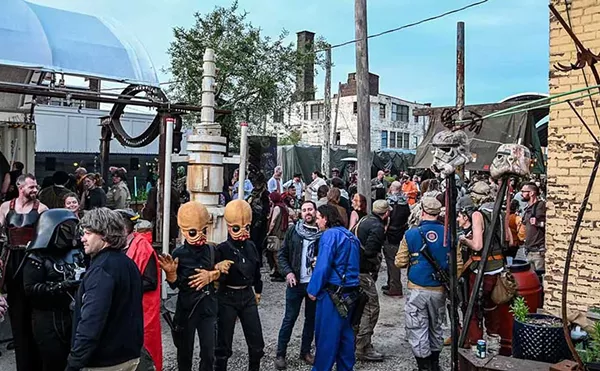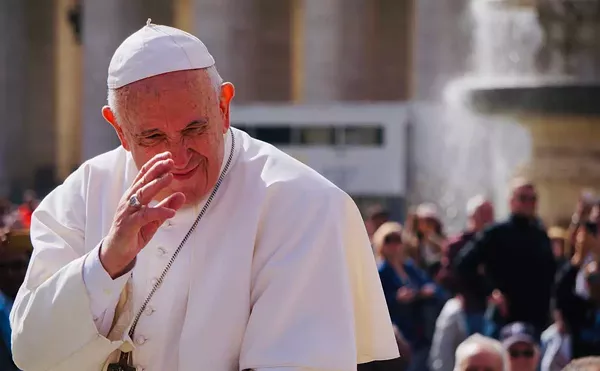Booty bomb
The Scene was a mythic Motor City dance show that never knew it was making TV history. They're doing it again.

Audio By Carbonatix
[
{
"name": "GPT - Leaderboard - Inline - Content",
"component": "35519556",
"insertPoint": "5th",
"startingPoint": "3",
"requiredCountToDisplay": "3",
"maxInsertions": 100,
"adList": [
{
"adPreset": "LeaderboardInline"
}
]
}
]
You may have been born here and still live in the city of Detroit. Perhaps you moved here from some other community but consider Detroit your adopted home. Many more of you were raised here, have departed the city limits for whatever reason yet still claim Detroit as your birthright.
Doesn't matter. It could be argued convincingly that you cannot consider yourself a true adult Detroiter if you don't know the answers to the following questions:
• It's six o'clock. What time is it?
• What's the name of this town?
• Are you ready to throw down?
• Can you complete the following phrase? "Sugar is sugar, salt is salt ..."
The appropriate responses, you know, are:
• It's time to rock! ("We rock, rock, rock, we don't stop. ...")
• "GEEK-town!'
• "YES ...WE ... ARE!"
• "... if you didn't get off, it's not my fault."
This is, of course, the language of The Scene, the mythic, notorious Detroit urban dance show on the old WGPR-TV (Channel 62) that turned Motown into Geektown five days a week from October 1975 to December 1987 — and lives on in perpetuity through the wonder of the Internet. There is one "official" website celebrating the series, at least four fan sites, and ferociously hip-shaking, Afro-waving classic video clips from the show's heyday are easily found on YouTube and Facebook.
They'll also be prominent on large overhead screens Saturday night in Detroit as part of the action at the first Official Scene "Still Doing It" Reunion Party, a rhythm-and-blues revival meeting for former dancers and fans Enchantment, the Detroit-born group that hit America's Top 10 in the '70s with songs like "Gloria" and "It's You That I Need," will perform live, and R&B singer Davina will showcase her new single, "Doin' it."
Nat Morris, the glib, raw-voiced emcee and executive producer of The Scene (he was "Natty Nat" or "Nappy Nat," depending on your level of admiration), says a reunion celebration was a very long time in the making.
"The idea has been around since about 10 years after the show went off the air," says Morris, now 63 and immersed in blissful self-proclaimed retirement. "We looked at it but we didn't get the support, so we moved on. We came back a few years later and looked at it again. But with the advent of Facebook and YouTube and the worldwide explosion of Detroit techno music that we used to dance to on the show, it was like, 'If not now, when?'
"It's something that should be done, just because of the number of people who have asked, 'When? When?' and me saying, 'One day, one day.' I figure like this, I've got to be in the second half of my life. I may even be in the fourth quarter, who knows? That was another motivating factor. We keep seeing people at funerals. Maybe we need to come together one more time for those who are alive and pay respect to the ones who are no longer with us, and do this thing so it's a fun occasion when we come together rather than a sad occasion."
That earnest mission may explain why, in his May 3 open letter to dancers and fans announcing the event, Morris took great pains to clarify that no ulterior motive was involved. "I did put in the letter, 'No, I am not trying to bring the show back and no, I am not trying to revitalize my career at all,'" Morris says. "My aim is to preserve the [show's] legacy. I'm very happy. I was in a very nice comfort zone and jumped back into the skillet, so to speak. My normal morning was wake up, have coffee, not worry about who I gotta call, what I gotta do. I didn't have to worry about any of this four months ago."
To ease his worries, Morris recruited two experienced Detroit promoters to help market the affair — David "Hump the Grinder" Humphries, whose "Hair Wars" competitions have become an international phenomenon, and Butch "Goldfinger" Anderson of Goldfinger Enterprises — and gave former dancers an incentive to make a few dollars off every ticket they sold. It all must have worked: Last week the $15 advance tickets had sold out and new tickets were being printed.
The Scene reunion also will pay tribute to WGPR-TV (now WWJ-TV) and R.J. Watkins, who kept the music playing by producing and hosting The New Dance Show on Channel 62 for eight years after The Scene left the air.
WGPR ("Where God's Presence Radiates") was the first African-American-owned television station in the nation when it signed on Sept. 29, 1975. Purchased by Detroit's International Free and Accepted Modern Masons, the station occupied the same rambling, ramshackle building on East Jefferson that housed its sister FM property. Like the new homeowner who buys his dream house only to realize there's no money left for furnishings, the purchase price of the television license left WGPR with virtually no budget for programming.
The station turned to "brokered" shows, where outside producers paid WGPR a flat fee for its airtime, and programs that were inexpensive to produce. Shaun Robinson, the glamorous Access Hollywood anchor, got her first TV break hosting a Channel 62 talk show called Strictly Speaking. However, next to Arab Voice of Detroit, a weekly variety series benefitting from metro Detroit's massive Arab-American population, the most popular show on the station by far was The Scene, taking its cues from the earlier local success of Robin Seymour's Swingin' Time and its nationally syndicated weekly contemporary, Soul Train.
Dance shows are relatively cheap to stage, dancers provide the visual entertainment, and being in Detroit meant many record labels were delighted to break their new singles and artists on a TV show here. Less than a month after WGPR became a reality, The Scene was on the air. This dance show, however, added a few flourishes uniquely its own.
The Electrifying Mojo, hottest DJ on Detroit radio at the time but infamously camera-shy, provided the recorded announcer intros and bumpers ("It's half-time of our show!"). The camera operators may be responsible for inventing the "booty-cam," creating angles and shots so ridiculously provocative that they would stop any typical channel surfer in his tracks. The Scene was the show that nobody admitted to watching, but everybody could tell you about the next day.
WGPR plucked Morris from the ranks of its radio personalities to double as TV host. Admittedly, it was a role he had to grow into. "I really came to Detroit to do radio," recalls Morris, a North Carolina native. "Television came to me. As a gift, really, unbeknownst to me. There's a clip from May '76 on YouTube with me wearing this red suit, and I am deejaying on TV! It's like the same script I was using on the radio, I used on television. It took me a number of years to evolve into a television host."
After a dozen years, audiences didn't tire of the show as much as Morris grew weary of trying to take it to a higher level. Except for a brief period with Albany Scene, where segments from Detroit were stripped into a companion series in Albany, Ga., The Scene never achieved the dream of a national broadcast to rival Soul Train, its gold standard. "The Scene was something I really tried to sweep under the rug after it was over, because it had been such a struggle to take it national," Morris admits. "We never could get the investment needed to be a national show. I had taken it as far as I could take it personally, so, when it was over, I was relieved. It was like a weight lifting off my shoulders."
What's more, because the cost of videotape didn't fit into WGPR's budget, only about 250 shows remain from the thousands of episodes telecast. "We didn't even record a lot of shows in those days," Morris reflects, sadly. "We went live. We were radio people. Or if we recorded it, we might need that tape to record over later. Hundreds of shows are just missing, lost or never recorded. I can't find Luther Vandross on the show. Teddy Pendergrass. Phyllis Hyman. There are a lot of great artists we had that we can't find evidence of now. We didn't know. We did not know the significance of what we were doing at the time."
Of all the dancers to grace The Scene's glimmering stage over the years — curvaceous LaWanda, video-savvy Montez, influential Yvonne or Daphne Andrews, who's flying in from New York for the reunion, to name a very few — no one has parlayed their TV experience into a more prosperous post-Scene career than "Fast Freddy" — aka Fred Anderson, who remains high in Detroit's public eye nearly a quarter-century after the show's demise.
"Detroit has been so kind to me," says Freddy, now 64, who worked fulltime as an operating room assistant for three area hospitals while dancing on the series, and now serves as a dance instructor, choreographer, model and professional deejay. "I love having fun, and I love seeing people having fun. I'm no stranger anywhere I go, I'm an instant party-starter, and I don't take it for granted. It's just a blessing, you know?"
And always, always, Freddy, who once was featured in GQ magazine, is dressed to the nines — or maybe the 10s, since perfection is his goal. "I dress up every day!" he says. "Every day God wakes me up I dress up, get out and have a good time. My grandfather used to tell me, 'The best reason to dress up is no reason at all.' It's not something I do to show off. It's something that makes me feel good."
Fast Freddy — a nickname derived from his early modeling career, not his signature dance moves — is overjoyed at the prospect of a reunion. "So many people really loved that show, and they have great memories of it," he says. "People come to me every day and beg me, 'Can I get excerpts from The Scene?' We were like the stars.
"The reason I'm such a recognizable face today is because of The Scene. Just like you see newscasters every day, The Scene was on 12 years, five days a week. And it came on sometimes two or three times a day! People love seeing people they see on TV. They live through you."
Can he still perform the dazzling moves he perfected on The Scene? "I can still do the moves, trust me," Freddy says. "I do them every day. Some days I'm Not-So-Fast-Freddy, but I'm still working."
"The fact that it's on videotape, some of the dancers have already shown these clips to their grandkids," Morris notes. "I've told some of them we'll probably live at least 100 years after we're gone. After everyone on that show is dead and gone, those tapes will still be around, When I was doing it, I know there was no serious thought about the future. It was like, 'OK, we've got a show to do; let's do the best we can today and see what happens.' We never thought about being part of history."
Saturday, July 16 at 8 p.m. in Bert's Warehouse Theatre, 2727 Russell in Eastern Market. Enchantment and Davina perform live. Visit thescenereunion.com or contact 313-737-4002 for ticket and other information.






